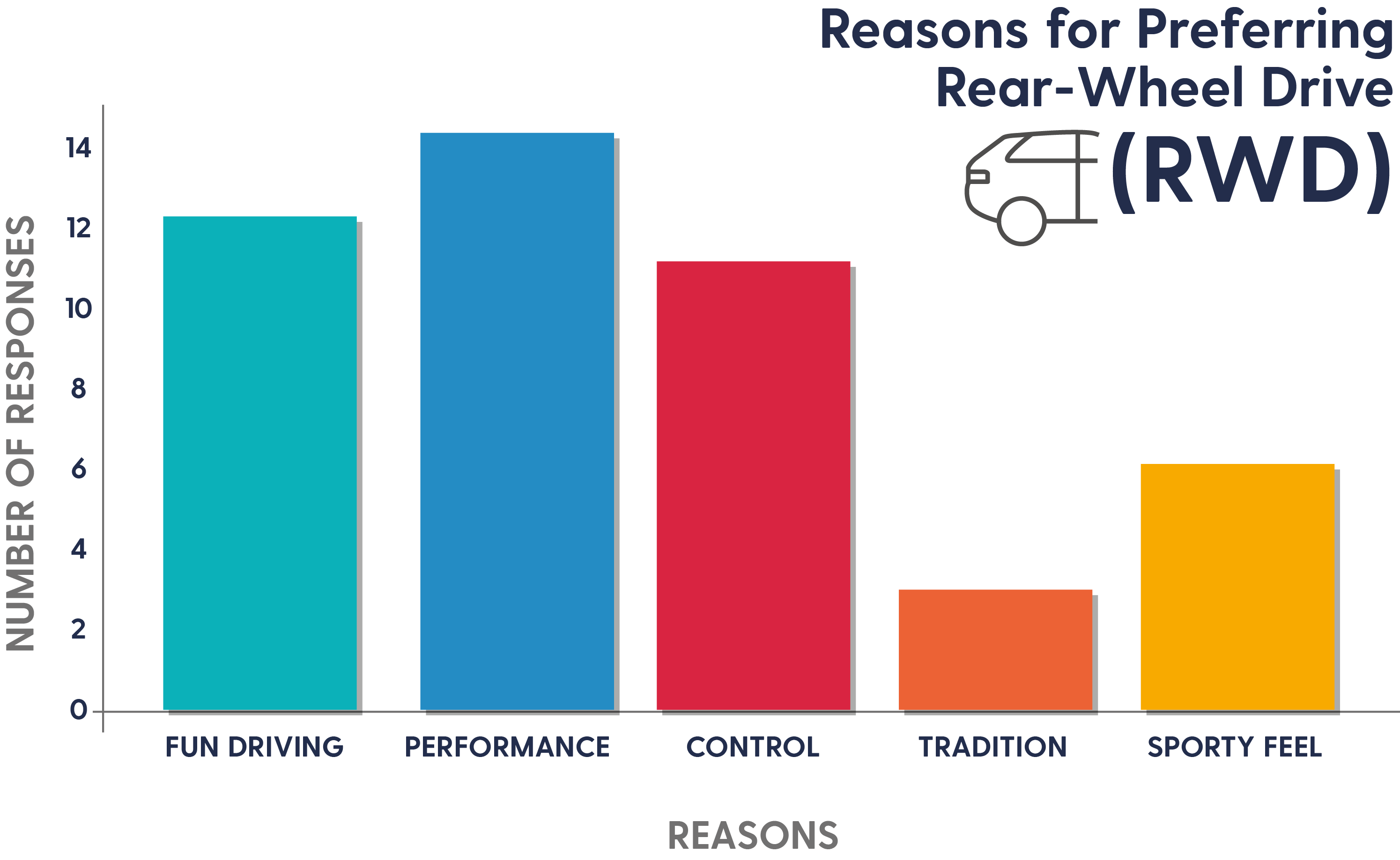FWD (front wheel drive) and RWD (rear wheel drive) are the two most popular drive train configurations used in vehicles. The primary differentiator between the two is that in an FWD drive vehicle, the power from the engine is primarily sent to the front wheels. In contrast, on the RWD, the energy from the motor is sent mainly to the rear wheels.
The decision between the two options can be subjective and based on personal preferences. In the forthcoming article, we will delve into the primary distinctions between RWD vs FWD. Additionally, we have carried out a survey in which we asked car enthusiasts about their preferred drivetrain and the reasons for their choice. You can find the survey results below.
Here are the following key differences between the two:
Table of Contents
Front Wheel Drive Vs. Rear Wheel Drive
Here are the following differences between the two:
1. The Use Case
Front-wheel drive is commonly found in compact cars and economy models, and it is often chosen for smaller vehicles due to its space-efficient design, allowing for more interior cabin space.
Rear-wheel drive is attributed to high performance; hence, it is found in sport, luxury and high-performance vehicles. Rear-wheel drive is appreciated due to its ability to offer a more engaging and dynamic driving experience.
2. Advantage
FWD car when compared to RWD car is less mechanically complex and the primary reason is that in an FWD vehicle the engine, transmission, and front axle are typically aligned more straightforwardly. The power from the engine goes directly to the front wheels, eliminating the need for a driveshaft or a separate axle as in the case of RWD vehicle. The less mechanically complex nature of FWD makes them more cost-effective and have low maintenance, as the FWD systems tend to have fewer components that require maintenance than rear-wheel drives. Other advantages include better fuel efficiency, space efficiency, simplicity of design, weight distribution, and packaging.
Despite its mechanical complexity, Rear-Wheel Drive (RWD) offers numerous advantages. RWD has a better weight distribution, nearly perfect 50:50 between the front and rear axles. This feature enhances stability and handling, especially during high-speed or aggressive cornering. Also, RWD has better traction, which increases the acceleration as it provides excellent traction due to the weight transfer to the rear wheels during acceleration. Other advantages include better towing and hauling, durability, and performance. It also provides better customisation and performance modifications due to its mechanism compared to the RWD.
3. Feel and driving experience
In terms of the driving experience, the rear wheel provides more stability. Turning is not good in FWD compared to RWD, and the main reason is the understeering. Due to its mechanism, its front tires lose grip before the rear tires during aggressive cornering, causing the vehicle to push wide in turns. FWD is again a good option when driving in snow and slippery areas, and the main reason is traction. FWD offer good traction in slippery or wet conditions due to the engine's weight being over the front wheels. This makes FWDs a perfect choice for driving in adverse weather conditions.
RWD, on the other hand, is more vital towards the balance and performance side. Due to a more balanced weight distribution, it provides better handling. The overall feel is very engaging and dynamic, as due to the mechanism, the driver feels more connected to the vehicle and more in control than FWD. Due to its ability to harness the power of powerful engines effectively, it provides a firm feel.
User Experiences: Comparing RWD and FWD Preferences
We recently surveyed car enthusiasts to ask them about their preferences and reasons. What is their ideal choice when it comes to RWD vs FWD, and why? Here are the results:
According to the research, 30 respondents preferred RWD over FWD, whereas 17 preferred FWD. Additionally, more than 10 respondents mentioned owning 4x4 vehicles, and two chose AWD as their preferred mode. (Although 4x4 and AWD were not specifically mentioned in the survey, car enthusiasts provided responses considering the open nature of the survey)..png)
All wheel drive (AWD) vehicles and four-wheel drives are the other two drive configurations that vehicles come with. The AWD and 4*4 vehicles send power to all four wheels, providing better traction in challenging road conditions like rain or snow. 4*4 vehicles are typically designed for off-road and can be manually switched between 2-wheel drive and 4-wheel drive modes. AWD is more suited for on-road use as its system operates automatically, while 4x4 is more suited for off-road journeys.
The survey was open-ended and qualitative. Then, the responses were analysed using thematic analysis so that we could better understand the data. Here is the following result for the analysis:
Based on our research, people prefer FWD for the following reasons presented in the chart.
.png)
The bar chart highlights the reasons for preferring Front Wheel Drive (FWD), and safety emerges as the top factor. As discussed, FWD is considered safer because of its traction, stability, handling and simplicity of design. Also, people prefer FWD due to its economic nature. FWD vehicles offer better fuel efficiency and low maintenance costs compared to FWD. Also, insurance is another reason people prefer FWD because FWD vehicles are typically associated with more practical, family-oriented cars, which statistically have fewer accidents and claims.
Enthusiasts Prefer rear-wheel drive based on the following reasons:

The chart analysis reveals that performance is the most celebrated aspect of RWD vehicles. Users prefer RWD because it gives superior handling and acceleration balance, which results in a more fun and engaging driving experience. RWD's control, especially in handling and power distribution, is another notable reason for preference. Also, tradition and a sporty feel are less frequently mentioned but are still significant, pointing to a subset of drivers who value the classic driving experience.
Maintenance
Due to the difference between the two mechanisms, there is a difference in the maintenance of both drive trains. Hence, our expert, Chris Marren, says the following about maintaining the FWDs.

On the contrary, the maintenance of RWD vehicles is more on the internal mechanism side. Our Motorfinity expert Cameron John says the following about the maintenance of the RWDs:

It has unique features, like all-wheel drive, which is uncommon in this class, and a stylish interior and exterior, which give it an amazing look and feel.
It is not the quickest in its class. It is more than adequate to meet all your needs. It is an ideal car for a small family.
The ride quality is extremely good for a vehicle of its class.
Conclusion:
To summarise, individuals who value practicality, safety, and economic considerations prefer Front-Wheel Drive (FWD) for its reliable handling, which provides a stable driving experience for daily commuting. High respondents selecting RWDs and 4x4s indicate the vehicle's demand that offers more control rather than a more automated feel. Conversely, Rear-Wheel Drive (RWD) is the choice for those seeking a more engaging and dynamic driving experience, offering superior handling, increased control, and a sporty sensation.
Motorfinity
At Motorfinity, we pride ourselves on offering exclusive discount across all makes and models. Whether you're looking for efficiency, style, or cutting-edge technology, our selection is designed to meet every need.
You can choose from Personal Contract Purchase (PCP), Hire Purchase (HP), and leasing deals. Each option provides flexibility and benefits tailored to different driving habits and budgetary needs.
Are you eligible?
Our nations Armed Forces, Veterans, Emergency Services, NHS, Police and Prison Services, the Education and Social Care sectors and more form our eligible audience.





